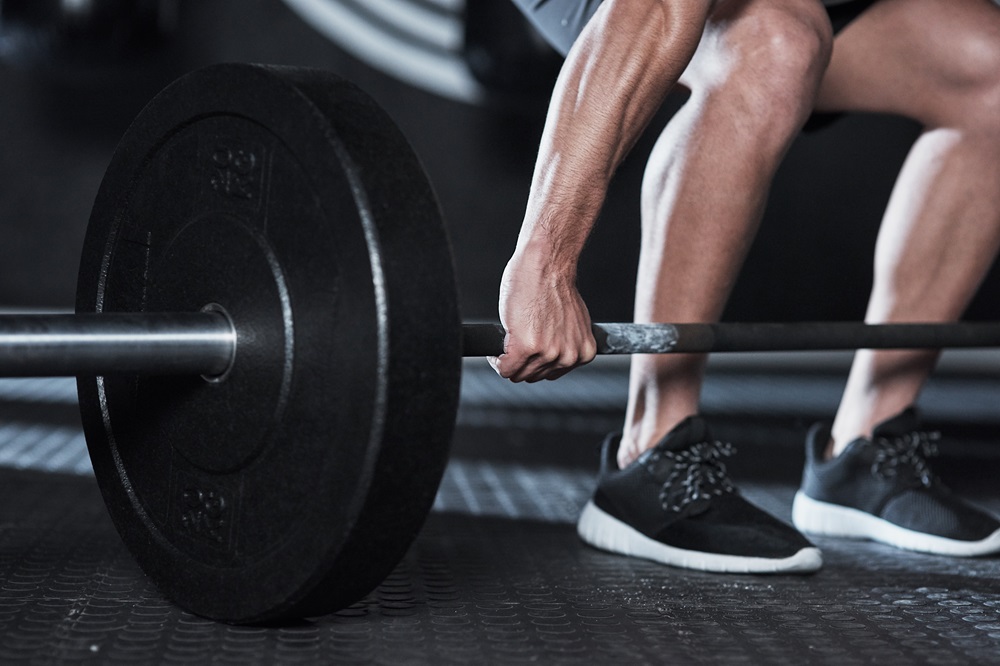Deadlift – Technique, Types, Benefits

The deadlift is a popular compound exercise and a staple in many athletes’ training routines. It’s a demanding movement that can support spinal stability, improve posture, and promote strength and muscle growth. But what exactly is a deadlift, what are its variations, and how should it be performed correctly? Can it be done at home?
Table of contents
Deadlift - what is it?
The deadlift is a complex, multi-joint exercise that activates several muscle groups at once. It involves lifting a weight – typically a barbell loaded with plates – from the floor to hip height, reaching a fully upright position, and then lowering it back down.
This strength-building movement can be adapted in various ways to suit an athlete’s needs and skill level. But where does the name come from? The term “deadlift” is believed to trace back to ancient Rome, where soldiers would carry fallen comrades off the battlefield. Because this task was physically taxing – especially on the lower back – Roman commanders developed training routines to teach proper lifting techniques to reduce injury risk and boost efficiency.
Deadlift - which muscles are involved?
The deadlift is a compound movement that targets multiple muscle groups. While the primary focus is on the lumbar and lower back region, many other muscles are engaged, including:
- erector spinae
- latissimus dorsi
- quadriceps and hamstrings
- quadratus lumborum
- gluteal muscles
- abdominal muscles
The classic deadlift also activates postural (core) muscles and arms (biceps and triceps). Its versatility makes it suitable for training both the lower and upper body.
Types of deadlifts
There are several variations of the deadlift, each targeting different muscle groups and accommodating different training goals. Common types include:
- Conventional deadlift – the basic form where the barbell is lifted from the floor in front of the athlete.
- Sumo deadlift – performed with a wider stance. The bar is gripped between the legs rather than outside them, shortening the range of motion and allowing heavier lifts.
- Stiff-leg deadlift – similar to the conventional version, but with straight legs. This variation places more emphasis on the back extensors.
- Romanian deadlift – resembles the stiff-leg version but allows for slightly more knee bend, targeting the hamstrings more effectively.
Other popular variations include:
- Deficit deadlift – performed while standing on a small platform to increase the range of motion and strengthen the initial pull from the floor.
- Rack pull – with the barbell placed on an elevated rack, this targets the top phase of the lift.
- Trap bar deadlift – uses a hexagonal bar that surrounds the lifter, offering neutral grip handles and a different load distribution.
- Dumbbell deadlift – uses dumbbells instead of a barbell, providing more freedom of movement and easier accessibility for beginners.
- Single-leg deadlift – can be done with dumbbells, kettlebells, or bodyweight, focusing on deep core, glute, and hamstring engagement.
Deadlift technique - how to perform it correctly
The deadlift is a demanding exercise that places stress on the spine and knees. Poor technique can increase the risk of injury, so mastering proper form is crucial. Here’s a step-by-step guide:
Starting position:
- Begin by positioning your feet hip-width apart under the bar, toes pointing slightly outward. The bar should be close to your shins.
- Brace your core and glutes, retract your shoulder blades, and push your chest slightly forward.
- Hinge at the hips and lower into a partial squat, gripping the bar with an overhand or mixed grip.
- Your hips should be below your shoulders and above your knees.
- Keep your neck neutral, aligned with your spine, and slightly extend your arms forward to help with balance.
The lift:
- Keep your back flat and eyes forward.
- Inhale deeply, then begin the lift by driving your hips upward and straightening your knees.
- Keep the bar close to your body and maintain a tight core.
- As you reach the top, exhale and fully extend the hips and knees without leaning back or overextending your lower back.
- Hold the upright position briefly.
The return:
- Take another breath and push your hips back, lowering the weight in a controlled manner while keeping the bar near your legs.
- Once the bar passes your knees, bend them and lower it to the floor.
- Exhale and reset before the next rep.
Deadlift - how to train?
While technique is the most discussed aspect of the deadlift, beginners also often ask: should I train at home or in a gym? How much weight should I lift? How many reps should I do?
Deadlifts can be done both at home and in the gym. However, beginners should ideally train under the supervision of a certified coach to build proper form, which is why starting out in a gym is often recommended. More experienced lifters with the right equipment and technique can safely perform deadlifts at home.
Training frequency, rep count, and load should all be tailored to the individual. It’s best to start with lighter weights and increase gradually. The weight used should be challenging enough to stimulate progress but not so heavy as to increase injury risk.
Before starting a strength program, it’s important to create a personalized training plan – ideally with the help of a coach. Beginners are typically advised to train deadlifts 1–2 times per week, while more advanced athletes may train 2–4 times weekly. Most programs include 1–6 sets of 2–6 reps per session.
Deadlift - benefits
The deadlift activates numerous muscle groups, supporting overall physical conditioning. It strengthens the skeletal muscles, promotes spinal stability, and enhances posture. It can increase muscular strength, support muscle growth, and help shape the physique. It also improves mobility and flexibility, particularly in the hips and back.
Regular deadlifting boosts grip strength, muscular endurance, and injury prevention – both during workouts and in everyday activities like lifting heavy objects. It’s also an effective calorie-burning exercise, supporting weight loss efforts, and can improve mental well-being.
Deadlift - contraindications
Despite its benefits, the deadlift isn’t suitable for everyone. People with lower back injuries or limited mobility due to a sedentary lifestyle should avoid this movement unless cleared by a healthcare professional.

